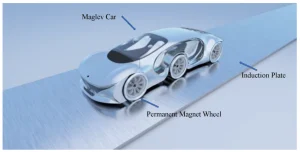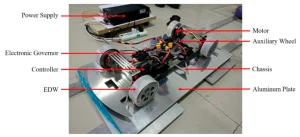Japan is on the cusp of revolutionizing transportation with its groundbreaking magnetic levitation (maglev) technology, poised to eliminate the need for traditional engines and batteries. This innovation, developed by the Quantum Machine Unit at the Okinawa Institute of Science and Technology (OIST), presents a future where cars glide effortlessly without friction, leveraging magnetic fields for propulsion.
The Technology
Magnetic Levitation Explained Maglev technology uses magnetic fields to suspend objects without physical support, eliminating friction for smoother, more efficient movement. While maglev trains in Japan and China utilize this technology, they require constant electrical power to maintain levitation. The OIST researchers’ innovation changes this, significantly reducing the energy needed for propulsion.
How It Works

The new maglev system developed by OIST requires power only at start-up to establish the initial magnetic field. Vehicles made of diamagnetic materials can then float above the track, moving without further electrical or mechanical thrust. This is achieved using plates made from a mixture of pulverized graphite and wax, with magnets arranged in a continuous grid beneath them to create the magnetic levitation effect.
Advantages Over Traditional and Emerging Technologies
Eliminating Engines and Batteries The primary advantage of this maglev technology is the potential to eliminate the need for engines and batteries, making vehicles lighter and more energy-efficient. This could usher in a new era of transportation where cars glide over tracks without the drawbacks of friction and gravity.

Comparison with Other Technologies
- Lamborghini’s Dual-Fuel Engine: While advanced, it still relies on traditional propulsion.
- Toyota’s Zero-Emission Combustion Engine: Impressive but involves conventional combustion.
- Germany’s Low-Emission Engines: These boast 95% fewer emissions but cannot match the complete elimination of engines and emissions offered by maglev cars.
Challenges and Future Prospects
Scaling the Technology The experimental prototype developed by OIST is small, and scaling it for practical, everyday use involves several challenges. One of the main issues is reducing the kinetic energy at the surface level to ensure efficient, self-sustaining movement.
Vortex Damping Vortex damping refers to the loss of energy in oscillating systems due to external forces. In maglev cars, preventing energy loss in the graphite immersed in a magnetic field is crucial for maintaining levitation and ensuring continuous, efficient movement.
Research and Development To make maglev cars a reality, researchers must address these challenges and refine the technology for practical applications. This includes improving the durability and efficiency of the materials used and developing infrastructure that can support widespread adoption.
Conclusion
Japan’s maglev technology presents a transformative potential for the automotive industry, offering a frictionless, engine-free, and battery-free mode of transportation. While significant challenges remain, continued research and development could overcome these hurdles, paving the way for a new era in transportation.
To Keep Updated Visit & Follow our Facebook Page Or Our Website

